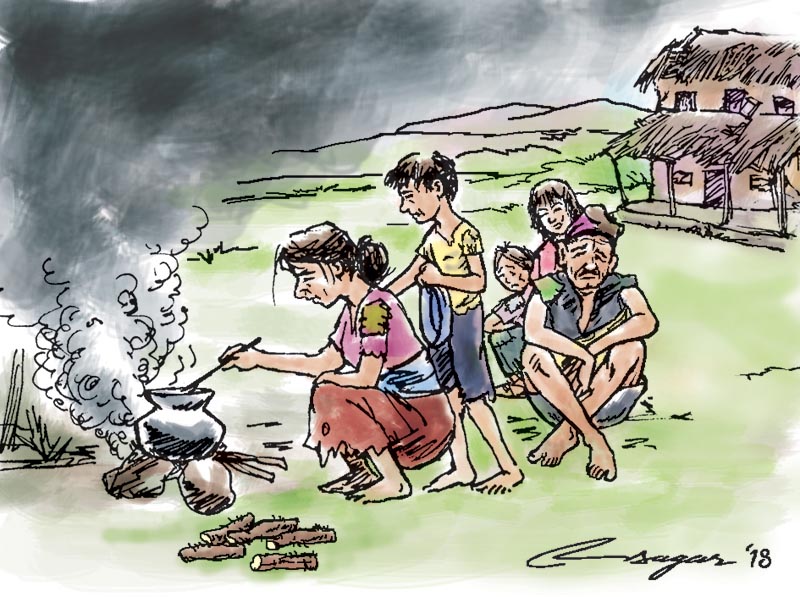Wisdom of eating: Chepangs’ food habits
The Chepang people for years have been relying on food sources available in forests and jungles, which contain a wide range of ingredients such as antioxidants, phytoestrogens and vitamins that keep many health problems at bay
For thousands of years, communities have relied upon their intuition and Mother Nature to keep themselves and their families healthy. Guided by their inner wisdom, our ancestors have been plucking healing plants from nature’s colourful pharmacy – fresh ginger to prevent nausea and calm the stomach, basil to get rid of common cold and beetroots to provide better nutrition to pregnant mothers, among others. The list could be very long.
Today this ancient intuitive wisdom is supported by scientific studies which only have confirmed what our ancestors already knew – that plants contain a wide range of ingredients such as antioxidants, phytoestrogen and vitamins that keep us healthy and keep many health problems at bay. Indigenous people have for hundreds of years have passed on their knowledge about plants and their health benefits to generations. They have been surviving on foods grown in nearby jungles and forests.
Scientists have proved that traditional food systems have healthy elements and high nutritional value, which and can contribute in mitigating malnutrition. Chepangs or Prajas, one of the indigenous communities of Nepal, have been gathering their food using their intuitive wisdom and traditional knowledge for years.
Local Initiatives for Biodiversity, Research, and Development (LI-BIRD), an organisation based in Pokhara which works to capitalise on local initiatives for the sustainable management of renewable natural resources and to improving the livelihoods of resource-poor and marginalised people, has conducted a research on foods used by Chepangs. It has found that Chepang people have generated enormous knowledge about large numbers of plant species on which they have been dependent for centuries.
Their traditional knowledge of the biodiversity is old and profoundly rich. Almost all households collect different wild plant species at different amounts, either for home consumption, for selling or for medicinal use.
However, Chepang children have often been found to be malnourished. During my visits to villages in Makawanpur and Dhading, I had observed Chepang people’s daily lives. Most of them were living in poor conditions, children were malnourished and literacy rate among them was poor. They told me about their food habits that they eat jungle fruits and plants such as aerial yam or air potato (Ghitta in Nepali), wild edible yam (Ban tarul), deltoid yam (Vyakur), nettle (Sisnu), Indian gooseberry (Amala) and fruits of Nepal butter tree (Chiuri).
At the same time, they also cultivate maize, sesame, cowpea, finger millet, black gram, broom corn millet, buckwheat and rice bean in whatever small pieces of land they have. However this is done with almost no tillage and agricultural inputs.
What Chepangs have been gathering from the jungles have long contributed to their food security and become an integral part of their traditional culture. Seeds, tubers, bulbils, rhizomes, roots, leaves, fruits and tender twigs among others are usually on their menu.
But what is happening these days is Chepangs too have been overwhelmed by the idea of eating “white rice”, hence they too have now put the traditional food items they had been consuming for years on the back burner.
Many of them think “white rice” has better nutritional values than the yams and are spending whatever little money they have for buying rice.
So, the impact on their health and economic status is quite visible.
If we could provide information about the nutritious values of their traditional foods and inspire them to use them, there could be less hunger and less malnutrition among Chepang children. The irony is our health workers too have little knowledge about Chepang people’s food habits. So the general assumption is “Chepangs are forced to survive on yams, nettle and millet and that they are in immediate need of rice”.
Let’s discuss some nutritional aspects of foods that Chepangs have been gathering from the jungles.
Aerial yam, wild edible yam, deltoid yam contain five times more protein that potatoes and sweet potatoes. They are also rich in fibre, micronutrients and chemicals that are used for the treatment of cancer, diabetes and heart diseases. They have been recognised as “health/functional food” -- when mixed with breads or flour, their nutritional value and palatability increase.
Wild edible yam is a top quality wild root crop, which is used as a staple food in the Chepang community. It has a cultural and religious importance in Nepali society. During Maghe Sankranti (the first day of Nepali month of Magh), people eat the tubers of various root crops.
Chepang people have been eating nettle for years. Nettle’s jagged leaves that are covered with stinging hairs are a good source of micronutrients, especially iron and fibre. Tender leaves of nettle are cooked with maize flour. Nowadays, diabetic patients have heartily included these stinging leaves into their menu. This is also gaining popularity at high-end hotels, with tourists spending quite a good amount of money on what is called “nettle soup”.
There is a need to inspire the community to use these natural food sources in a proper way to save them from suffering from malnutrition.






